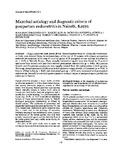| dc.contributor.author | Temmerman, M | |
| dc.contributor.author | Laga, M | |
| dc.contributor.author | Ndinya-Achola, JO | |
| dc.contributor.author | Paraskevas, M | |
| dc.contributor.author | Brunham, RC | |
| dc.contributor.author | Plummer, FA | |
| dc.contributor.author | Piot, P | |
| dc.date.accessioned | 2013-04-26T11:18:58Z | |
| dc.date.available | 2013-04-26T11:18:58Z | |
| dc.date.issued | 1988 | |
| dc.identifier.citation | Genitourin Med. 1988 Jun;64(3):172-5. | en |
| dc.identifier.uri | http://hinari-gw.who.int/whalecomwww.ncbi.nlm.nih.gov/whalecom0/pubmed/3137152 | |
| dc.identifier.uri | http://erepository.uonbi.ac.ke:8080/xmlui/handle/123456789/17076 | |
| dc.description.abstract | Using a protected triple lumen device, Neisseria gonorrhoeae or Chlamydia trachomatis, or both, were isolated from the endometriums of five out of 35 women with clinical postpartum endometritis compared with none of a control group of 30 puerperal women without endometritis (p less than 0.05) in Nairobi, Kenya. These sexually transmitted agents were also found in 12 cervical specimens from women with and three without postpartum endometritis (p = 0.04). Mycoplasma hominis and Ureaplasma urealyticum were equally isolated from the endometrium in both groups. Histology showed plasma cell infiltration in 6/25 patients compared with 1/22 controls (p = 0.06). A history of foul lochia (p less than 0.01) and abdominal pain (p = 0.02) were associated with postpartum endometritis. Sexually transmitted agents appear to be major causes of puerperal upper genital tract infections in Nairobi.
PIP:
In Nairobi, Kenya, researchers enrolled 35 women at 7-9 days postpartum who delivered vaginally and had clinical endometritis (purulent lochia, fever, uterine tenderness, or uterine subinvolution) and 30 puerperal women without endometritis in a case control study. The study aimed to examine the association between clinical criteria and microbial and histological findings in diagnosing postpartum endometritis and the role of various microorganisms in the etiology of this infection. Cases were significantly more likely to have foul lochia (51.1% vs. 20%; p = .005) and abdominal pain (77.1% vs. 46.7%; p = .02). Laboratory personnel were able to isolate both Neisseria gonorrhoeae and Chlamydia trachomatis significantly more often from the cervices and the endometria of the patients than from the controls. Each of these 2 microorganisms were also isolated more often from the endometria of patients than of controls (3 patients vs. 0 patients for both N. gonorrhoeae and C. trachomatis), but the difference was not significant. The researchers could not determine the etiology of postpartum endometritis in the remaining two-thirds of cases. Isolation rates for Mycoplasma hominis and Ureaplasma urealyticum from the cervices and endometria were essentially the same in both patients and controls. Moderate or severe plasma cell infiltration occurred in 24% of cases and 4.5% of controls (p = .06). No correlation between histology and microbiology existed, however. These findings suggest that controlling maternal sexually transmitted disease would reduce postpartum pelvic infections and secondary infertility. | en |
| dc.language.iso | en | en |
| dc.title | Microbial aetiology and diagnostic criteria of postpartum endometritis in Nairobi, Kenya. | en |
| dc.type | Article | en |
| local.publisher | Department of Obstetrics and Gynaecology, University Hospital, University of Brussels, Belgium. | en |


